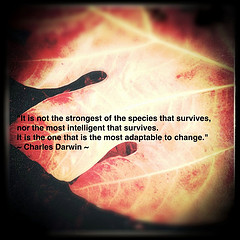|
|
|
Monday, August 1st, 2016
It’s amazing to me, but looking back over more than a decade of writing I find posts that still impress, with information that is as useful now as when it was written. Golden Oldies is a collection of what I consider some of the best posts during that time.
Visions. Everybody has them — CEOs, entrepreneurs, psychotics, and, of course, politicians (especially politicians). It’s not the visions that are the problem; the problems happen when the visionary’s focus is on purity, instead of pragmatism; as amply illustrated below. Read other Golden Oldies here.
 There is a wonderful post by Kent Lineback at HBR called The Leadership Learning Moment That Wasn’t. In it he tells of blowing a great opportunity because he couldn’t get the other executives in the company to buy into his vision. There is a wonderful post by Kent Lineback at HBR called The Leadership Learning Moment That Wasn’t. In it he tells of blowing a great opportunity because he couldn’t get the other executives in the company to buy into his vision.
“What do you think is going on? I made an important point and everybody yawned and moved on.”
“It was an important point,” he [the consultant] said, “but you didn’t build any bridges.”
Lineback goes on to say that he thought long and hard about the consultant’s words and realized he was right.
“I didn’t build bridges. I didn’t reach out and connect with others on their terms. I talked at them. I had a solution, a beautiful vision. I knew the answer, and I spent my time telling everyone what it was and what the company had to do.
But that didn’t change anything.
I knew he was right. I knew I should do what he said. But I couldn’t debase my perfect vision by turning it into a free-for-all idea jam. Better to stay pure and fall on my sword, a martyr.”
That is one of the great problems of leadership visions, they are the property of one person; one person who will do almost anything to sell the vision—anything except share and modify it.
Leadership visions happen at all levels of a company from the CEO down to the newest supervisor.
It’s a side effect of drinking the leadership Kool-Aid, so you might want to think twice before indulging your thirst.
Image credit: Khürt Williams
Posted in Golden Oldies, Leadership | No Comments »
Tuesday, February 3rd, 2015

Is your boss rigid? Or maybe it’s your colleagues — or even you?
Rigid in action, thought or imagination?
Rigidity is a mental habit and, although often grounded in ego, often has as much to do with the corporate culture as with the individuals involved.
Openness is based on trust and if the people or the culture don’t foster trust then you should expect them to be ultra turf conscious, not interested in sharing, and prone to spending large amounts of energy fighting every new thing that comes along.
Twenty-somethings often regard rigidity as synonymous with age, but that’s a wildly inaccurate assumption and not born out by the facts.
While the age thing may play on the surface, it should be recognized that rigidity is present in all ages.
There are a lot of pretty rigid twenty- and thirty-somethings and no one in their right mind ever called a teenager flexible
If you have any doubts about this, try getting your twenty-something co-workers to approach a subject from any position other than the one they advocate.
Rigidity is not so much about doing it differently as it is about doing it ‘my/our way’ and that attitude has substantially worsened.
It seems that everybody has a group and while their group is OK, other groups, i.e., any that don’t agree with theirs, are rigid, inflexible and standing in the way of progress.
In many ways rigidity is a form myopia.
The cure is simple to state, but difficult to implement, because it requires truly honest self-appraisal, which is not something with which most people are comfortable.
The thing to remember is that there’s value to be found in most approaches and when that value is tweaked and/or merged with other methods the result is usually worth far more than the original.
~~~~~~~~~~~~~~~~~~~~~~~~~~~~~~~~~
For additional input and insights to being a boss, be sure to check out the March Leadership Development Carnival.
Flickr image credit: trombone65
Posted in Ducks In A Row, Personal Growth | No Comments »
Tuesday, August 27th, 2013

Common wisdom says that the larger a company the harder it is to get management to listen, especially when it goes against fundamental corporate practice.
Franchises are even worse and the longer they’ve been around the less they are likely to listen to a franchisee, let alone a new one.
But when they do the result can go way beyond the most optimistic prediction.
The frozen-yogurt giant credits the 32-year-old’s success with pushing them to embrace the self-serve model – a move that has reinvigorated the company and led to exponential growth.
TCBY had been around 30 successful years when Samuel Batt was approved for a new franchise in 2010.
He grew up eating TCBY, but wanted to incorporate self-service—enabling customers to choose flavors, toppings and quantity of each—in his new franchise.
Sounds old hat today, but DIY was just gaining traction in new venues back then.
Long story short; the powers-that-be said yes, as long as he kept the branding.
And within three weeks, his location was one of the top-five most profitable franchises in the country. (…) About half of TCBY’s nearly 500 franchises across the country have embraced the new model to great success, each doing from 25 percent to 200 percent better in sales than with the traditional model, Brian Mooney, director of operations for the Eastern U.S., said.
Management could have just as easily said no.
Compare TCBY’s attitude to Steve Ballmer’s at Microsoft; they are close to the same age—TCBY is just six years younger than Microsoft.
In 2007 Ballmer said, “There’s no chance that the iPhone is going to get any significant market share.”
He didn’t listen to either his own people or the industry when they said that mobile and the cloud were the future—or maybe he was in denial.
But as I recall, Bill Gates didn’t listen when staff tried to tell him that the Internet was going to be really, really BIG.
Bosses at every level, not just CEOs, have a choice.
They can choose to listen and be flexible—or not.
Flickr image credit: jessica mullen
Posted in Culture, Ducks In A Row, Innovation | No Comments »
Thursday, April 28th, 2011
 Entrepreneurs, mompreneurs, solopreneurs, micropreneurs, partnerpreneurs, kidpreneurs, the list grows daily. Entrepreneurs, mompreneurs, solopreneurs, micropreneurs, partnerpreneurs, kidpreneurs, the list grows daily.
If you listen to the media these days the only career of merit is to be a somethingpreneur and that those who work for large companies should quit to start their own biz or be branded as losers.
I am taking this opportunity to state categorically, once and for all that that’s a crock.
Seriously.
There are millions of talented, driven, high producers who work happily in large companies of all kinds across the country.
They aren’t there because they are scared to do their own thing.
They aren’t there because they aren’t innovative or lack creativity.
They aren’t there because they are lazy, uncaring or stupid.
They don’t deserve to be labeled drudges or losers because they thrive in the corporate world.
They are the people who will buy or use the somethingpreneur products.
Their employers are the companies that will acquire or partner many of the somethingpreneur companies.
The somethingpreneur ecosystem would crash and burn without these companies and their employees.
The companies would crash and burn without those employees.
Somethingpreneurs couldn’t scale their companies without these people.
The idea that a person is better because they founded or work in a startup is hype; they are different, not worse or better—just different.
No matter the size of the company, it comes down to cultural fit.
Not just the company culture, but the specific culture propagated by the manager for whom they work.
It’s not just about risk-taking. The days when corporate size, unions, public service or professional degrees (doctors, lawyers) mitigated job risk are long gone.
It’s not even about a person’s accomplishments in their previous/current job.
It’s about what that person would do in your company’s culture and under your management.
Image credit: http://www.flickr.com/photos/koalazymonkey/5089128512/
Posted in Entrepreneurs, Hiring | No Comments »
Friday, January 28th, 2011

There is a wonderful post by Kent Lineback at HBR called The Leadership Learning Moment That Wasn’t. In it he tells of blowing a great opportunity because he couldn’t get the other executives in the company to buy into his vision.
“What do you think is going on? I made an important point and everybody yawned and moved on.”
“It was an important point,” he [the consultant] said, “but you didn’t build any bridges.”
Lineback goes on to say that he thought long and hard about the consultant’s words and realized he was right.
“I didn’t build bridges. I didn’t reach out and connect with others on their terms. I talked at them. I had a solution, a beautiful vision. I knew the answer, and I spent my time telling everyone what it was and what the company had to do.
But that didn’t change anything.
I knew he was right. I knew I should do what he said. But I couldn’t debase my perfect vision by turning it into a free-for-all idea jam. Better to stay pure and fall on my sword, a martyr.”
That is one of the great problems of leadership visions, they are the property of one person; one person who will do almost anything to sell the vision—anything except share and modify it.
Leadership visions happen at all levels of a company from the CEO down to the newest supervisor.
It’s a side effect of drinking the leadership Kool-Aid, so you might want to think twice before indulging your thirst.
Image credit: http://www.flickr.com/photos/khurt/5252851284/
Posted in Leadership | No Comments »
Tuesday, December 14th, 2010
 There is much talk of corporate culture these days, but you don’t often hear about corporate traditions, yet traditions are a part of culture. There is much talk of corporate culture these days, but you don’t often hear about corporate traditions, yet traditions are a part of culture.
The primary definition of ‘tradition’ is “the handing down of statements, beliefs, legends, customs, information, etc., from generation to generation, esp. by word of mouth or by practice,” which is pretty much the definition of culture.
But whereas culture looms large in people’s minds, traditions are more bite-sized—a special lunch, holiday treats, secret Santas—and lend themselves to more general input.
December is a month of traditions and I have questions about yours.
Who sets traditions for your team, department or company?
Are they generated spontaneously by the people or do they stem from the bosses at each level? Do they have current meaning or did they originate in the distant past? Are they set in stone, with little or no relevance to current employees or do people embrace, participate and enjoy them?
The best traditions are those that come from people at all levels and stay flexible, so they can grow and change as the people, culture, company and world grow and change.
This year take the initiative and start a tradition in your organization, a tradition that benefits/encourages/transcends and, most of all, brightens the future.
Flickr image credit: http://www.flickr.com/photos/zedbee/103147140/
Posted in Culture, Ducks In A Row | No Comments »
Tuesday, July 21st, 2009
A few weeks ago I told you about my client who “acquires houses out of foreclosure, rehabs and rents the properties, then sells the properties to investors” and the consequences of the unintended craziness involved in the auctions in Texas.
 Unintended consequences sometimes seem to be the primary result of human actions. It is safe to assume that no one planned to cause global warming or the current economic meltdown. Unintended consequences sometimes seem to be the primary result of human actions. It is safe to assume that no one planned to cause global warming or the current economic meltdown.
These are just unintended consequences, but each one is much, much larger than the sequence of intentional human actions which led up to it. Given that we do not have perfect foresight, unintended consequences appear to be truly unavoidable. But they don’t have to be tragic.
Goals, Judgment, Flexibility, and Transparency
We can reduce the negative effects of unavoidable consequences.
Consider a sailor navigating a sailboat into a harbor marked by a lighthouse. Unfortunately, this sailor does not have GPS or an electronic autopilot, so he has to steer the boat manually, using the tiller. He sets the boat on a course to the harbor, using the lighthouse as the marker. Almost immediately the wind, waves, and tide push the boat off course. The sailor constantly corrects the boat’s heading to keep it on course for the harbor. Sometimes the boat has to change course to avoid larger ships heading into port. Most of the time the boat is off course, but due to the sailor’s constant corrections it makes progress toward the goal.
Passengers on the boat may not know how to sail, but they can see the lighthouse and can use the radar screen to track the progress of the boat amidst other ships. They can tell, for themselves, that the boat is on track and making progress.
The sailor has a clear goal and uses his judgment and flexibility to keep the boat heading to port. The analogy to our economic situation is obvious—while the sailor is guiding the boat to a safe harbor; our economy feels like it is careening out of control, heading toward the rocks.
Things to Think About
Given that most of us cannot significantly influence the government or the national economy we need to look closer to home.
- How do you guide your business?
- How does your team set goals?
- How do you encourage transparency?
- How much freedom do you allow your employees to use their own judgment?
- Do your policies look like the US Constitution (only 4,440 words) or like the US Tax Code (over 400 volumes)?
One More Consequence
Recently I have found a new opportunity, much too interesting to pass up. To pursue this new opportunity with the attention it deserves, one unintended consequence is that I must let go of this blog. With great appreciation for you readers and with many thanks to Miki Saxon, who gave me this opportunity to speak directly with you.
I close with the heartfelt wish that you follow your dreams all your life; that you may fulfill your dreams and that they may fulfill you.
Sincerely,

Posted in Business info, Strategy | No Comments »
|
 Subscribe to
Subscribe to
MAPping Company Success
About Miki 
Clarify your exec summary, website, etc.
Have a quick question or just want to chat? Feel free to write or call me at 360.335.8054
The 12 Ingredients of a Fillable Req
CheatSheet for InterviewERS
CheatSheet for InterviewEEs™
Give your mind a rest. Here are 4 quick ways to get rid of kinks, break a logjam or juice your creativity!
Creative mousing
Bubblewrap!
Animal innovation
Brain teaser
The latest disaster is here at home; donate to the East Coast recovery efforts now!
Text REDCROSS to 90999 to make a $10 donation or call 00.733.2767. $10 really really does make a difference and you'll never miss it.
And always donate what you can whenever you can
The following accept cash and in-kind donations: Doctors Without Borders, UNICEF, Red Cross, World Food Program, Save the Children
*/
?>About Miki
About KG
Clarify your exec summary, website, marketing collateral, etc.
Have a question or just want to chat @ no cost? Feel free to write
Download useful assistance now.
Entrepreneurs face difficulties that are hard for most people to imagine, let alone understand. You can find anonymous help and connections that do understand at 7 cups of tea.
Crises never end.
$10 really does make a difference and you’ll never miss it,
while $10 a month has exponential power.
Always donate what you can whenever you can.
The following accept cash and in-kind donations:
|
There is a wonderful post by Kent Lineback at HBR called The Leadership Learning Moment That Wasn’t. In it he tells of blowing a great opportunity because he couldn’t get the other executives in the company to buy into his vision.






 Entrepreneurs, mompreneurs, solopreneurs, micropreneurs, partnerpreneurs, kidpreneurs, the list grows daily.
Entrepreneurs, mompreneurs, solopreneurs, micropreneurs, partnerpreneurs, kidpreneurs, the list grows daily. There is much talk of corporate culture these days, but you don’t often hear about corporate traditions, yet traditions are a part of culture.
There is much talk of corporate culture these days, but you don’t often hear about corporate traditions, yet traditions are a part of culture. Unintended consequences sometimes seem to be the primary result of human actions. It is safe to assume that no one planned to cause global warming or the current economic meltdown.
Unintended consequences sometimes seem to be the primary result of human actions. It is safe to assume that no one planned to cause global warming or the current economic meltdown.

